Learn more about the natural environments of St. John Virgin Islands: beaches, mangroves, salt ponds, coral reefs sea grass beds as well as the inland environments found in the forests, mountains valleys, lowlands, and guts.
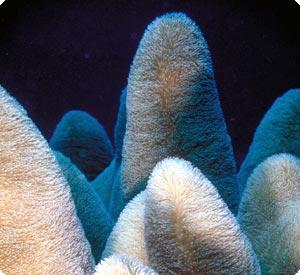
The Coral Reef
Spectacular snorkeling and scuba diving bring many tourists to St. John each year. They eagerly anticipate the experience of exploring the underwater wonderland that they have read about in travel books or heard about from friends. Where do these visitors go when they don their masks, fins and snorkels? First and foremost they seek out that diverse and colorful underwater community called the coral reef.
If our underwater explorers were to venture just a short distance away from the reef, they would encounter an almost barren sandy bottom with a lot less going on and a lot less to see. In general, life is sparse in tropical seas, except for around the coral reef, which is the underwater equivalent of an oasis in the dessert.
There is a richness of life on the reef that defies the imagination. The coral reef provides an environment for all the major phyla, or classifications, of plants and animals on the planet including thousands of species of fish, corals, sponges and marine plants. In fact, twenty five percent of all marine species live around coral reefs even though they cover only a tiny fraction (0.2%) of the ocean floor. The only other biological community on Earth containing such a large diversity of life forms and having an equivalent ecological importance is the tropical rainforest.
The coral reef is especially important to us on St. John. The reef protects our coastline from the full force of the sea, preventing erosion of the coast and allowing for the establishment of other important marine environments such as mangroves and undersea grasslands, which serve as nurseries for most of our marine life. Moreover, the soft white sand of our world-renowned beaches is a product of the coral reef. Without the coral reef there would be no beaches, no fish, no fishing and more than likely, no tourism, no jobs and no money.
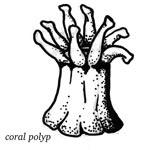
Coral polyps are members of the Phylum Cnidaria (Nigh DARE-ee-uh). Animals of this group live in the sea. They are simple bag or cup-shaped animals with only one opening into their digestive tracts. All Cnidarians have tentacles surrounding this opening, which contain coiled threads of stinging cells called nematocysts.
There are two basic types of Cnidarians, medusa and polyps. Medusa float around freely and include jellyfish of all types. Polyps attach themselves to the bottom and live rooted to one spot. Examples of polyps are sea anemones and corals.
The main difference between sea anemones and corals is that sea anemones live individually, while coral polyps form colonies, which over time may become quite large. Generations of coral colonies make up the coral reef, which can be immense. Australia’s Great Barrier Reef, for example, would cover an area extending from St. John to Miami with a width of more than 40 miles in some places.
In her book, The Nature of the Islands, Virginia Barlow writes, “Some Caribbean reefs contain several times the building materials that exists in New York City”.
The basic element of this magnificent environment is the diminutive coral polyp, an animal so small that as many as 250 could occupy an area of one square inch.
Perfect Partnership
Coral polyps and St. John construction workers have some things in common. They both are in the business of building large and important structures. While construction workers build things like homes and gathering places for human beings, coral polyps build coral reefs, which serve as homes and gathering places for the members of the reef community. Also construction workers and reef building polyps both need food, not only to survive, but also to have sufficient energy to go about the arduous business of building.
The construction workers, however, have it a lot easier than the coral polyp. They live and work on St. John where food is plentiful. The polyp, however, lives and works, in the tropical ocean, a place where food is scarce.
Moreover, construction workers can get in their car or walk over to the market and get all the food they can afford. The polyp, on the other hand, cannot go out and get food. It is firmly rooted to the construction site and isn’t going anywhere. The polyp has to wait for food, scarce as it is, to come to it.
How does the reef building polyp deal with such adversity?
The coral polyp lives in a region where plankton is scarce and it cannot move about to capture its prey. The polyp is so designed that a potential meal that comes within its reach will not escape.
The coral polyp has a single opening into its digestive tract. This opening is surrounded by tentacles containing coiled threads of stinging cells called nematocysts. The nematocysts may be barbed, whip-like, sticky, or poisonous and when triggered they shoot out explosively to kill, grab on to, or stick to just about all the plankton that comes its way.
Food obtained in this manner, however, provides just about enough energy for the coral to survive, but not nearly enough to continue building the reef. Obviously our little coral polyps are going to need help.
Help for the polyp comes in the form of microscopic brown algae called zooxanthellae (zo-zan-THEL-ee). The polyp and the zooxanthellae form what is known as a symbiotic relationship in which each helps the other. The vulnerable algae are given a safe place to live within the body cavity of the polyp. Surrounded by the equivalent of a stone wall and protected by poisonous tentacles, the zooxanthellae need not worry about falling victim to any enemies.
In return the zooxanthellae provide 80% of the total amount of nourishment used by the polyp. During the daylight hour the zooxanthellae produce food through the process of photosynthesis, which it shares with the coral polyp. Since photosynthesis requires sunlight, coral reefs are only found in clear and relatively shallow water where light is able to penetrate.
The polyp’s great dependence on the zooxanthellae is the reason that many coral structures resemble plants. Like plants, they orient themselves to maximize their exposure to sunlight, sometimes branching out like trees or bushes. Paradoxically, the clear warm water of the tropics that contains so little for the polyp to eat provides the perfect environment for zooxanthellae to photosynthesize food, which it shares with the polyp.
Zooxanthellae provide another benefit for the polyp. They secrete chemicals that lower the acidity levels within the polyps. A low acid environment facilitates the production of calcium carbonate, the prime building material for the reef.
As we can see the relationship between zooxanthellae and coral polyps is of crucial importance to the creation, health and maintenance of the coral reef community. Without these microscopic algae and clear clean water in which to perform their function, there would be no coral reef.
The water temperature can also be too warm to support the coral reef as has happened lately. When the water is too warm the symbiotic algae will be expelled from the coral polyp resulting in a phenomenon known as coral bleaching, which if the high water temperature continues too long will cause the death of the coral organism. Much of the Great Barrier Reef has succumbed to this increase in water temperature as has much of our own coral reefs here in the Virgin Islands.
Water Clarity
Have you ever wondered why the water around the Virgin Islands is so clear? You may think that the reason for this is that the ocean here is less polluted than off the coast of the United States or Europe. This may be part of the story, but even in the most remote and unspoiled regions of the north the oceans are not nearly as clear as some of the more developed bays of St. John.
The real answer to the question has to do with an entity called plankton which The Concise Columbia Electronic Encyclopedia defines as: “very small to microscopic plants and animals that have little or no power of locomotion and drift or float in surface waters.” If you’ve ever looked carefully through the water using a dive mask you’ve probably seen the tiny, odd-shaped particles suspended in the water and drifting about at the mercy of the smallest currents. These particles are plankton that happen to be big enough to be seen by the naked eye. There are two classes of plankton, plant plankton, called phytoplankton and animal plankton, called zooplankton.
Phytoplankton are probably the most important life forms on the planet. To begin with, they provide food for all other life in the ocean. Moreover, because they are part of the plant kingdom, they nourish themselves through the process of photosynthesis, which uses sunlight to turn carbon dioxide and nitrogen into sugars and starches. One of the waste products of this process is oxygen. Phytoplankton, although microscopic in size, are so abundant that they produce the majority of the world’s oxygen, without which, life on our planet would not exist as we know it. Because phytoplankton need sunlight, they must exist close to the surface of the ocean. Zooplankton depend upon phytoplankton for food and form a planktonic layer immediately below the plant plankton.
Water Temperature and Resulting Currents
In colder parts of the world the ocean water is warmer on the bottom of the ocean than on the top, especially in the winter. Nutrients washed down from the land by rivers, as well as waste products of fish and other sea life, tend to settle towards the bottom. Warm water rises, and when the bottom of the sea is warmer than the top, the nutrients are swept towards the surface by rising currents. These nutrients act as fertilizer for the phytoplankton, and also may serve as food for the zooplankton. The presence of these nutrients near the ocean surface creates an abundance of planktonic life. There is so much plankton in these colder waters that the ocean appears murky. In the tropics the sun constantly warms the ocean surface, which, consequently, is warmer than the bottom. Lacking upward currents, nutrients tend to settle to the bottom of the sea and stay there. Planktonic life is scarce and the tropical waters are clear.
Sediments
Another phenomenon responsible for the clarity of the Virgin Island waters is the absence of major rivers and streams. The relatively small streams, or guts, that drain the mountain valleys of St. John and the rest of the Virgin Islands generally lead to salt ponds or mangrove swamps. This allows silt and sediments carried by the stream to settle in the pond or be filtered by the mangrove roots before entering the sea which minimizes turbidity or water cloudiness.
Seagrass
In addition, offshore coral reefs (that happen to be dependent on clear water for their very survival) protect the shoreline from the full force of ocean swells and thus keep bottom sediments from being too churned up. Underwater seagrass beds also keep water clear by slowing down bottom currents as well as by stabilizing the sea bottom with their complicated root system.
Environmental Concerns
Human beings can effect the water clarity in negative ways. Runoff from upland development such as dirt roads or excavations for buildings can cause turbidity. Also ineffective waste treatment can result in an undesirable increase in algae causing the water to be cloudy. Turbidity also has the nasty tendency to kill coral and thereby upset the natural balance of the offshore and coastal environment. If, however, we act responsibly and keep our ecosystems healthy and in balance with each other, we can continue to enjoy our magnificently clear water for many generations to come.
Mangroves
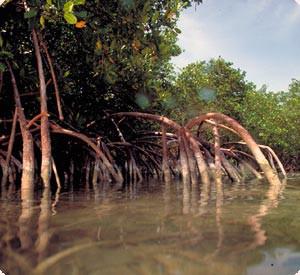
How Mangroves Depend Upon the Environment
Ecological environments everywhere depend upon one another for their survival. This is elegantly and plainly illustrated in the mangrove habitats of St. John as they quietly preside over the orderly transition of life between land and sea.
The term mangrove loosely describes those tropical trees or shrubs that are specially adapted to grow in salty, wet and muddy environments, such as the shallow waters of calm bays, the periphery of salt ponds, and within marshes and wetlands that are exposed to flooding and salt water intrusion. This is an extraordinary adaptation. Salt is generally abhorrent to plants of any variety. For example, when Union Civil War General William T. Sherman made his infamous “march to the sea”, he salted the fields of southern farmers, thus destroying the crops and rendering the farms useless for years to come. Mangroves not only have to withstand the rigors of a saltwater environment, but they also have to be able to hold firm in the loose and oxygen-poor soils characteristic of these locations.
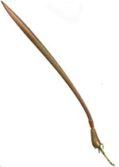
The red mangrove proliferates along the shorelines of shallow calm bays, both on the muddy shore and in the water itself. The red is the classic mangrove characterized by its numerous arch-shaped roots that start at the base of the tree and arch out and down into the water and mud. It also has distinctive seeds that at maturity look something like foot-long red pencils, which emerge prominently from the center of the mangrove’s leaf clusters.
When the red mangrove seedling matures, it falls from the tree into the water. Here, it can stay alive and afloat for up to a year. As the seedling moves at the mercy of the winds and gentle currents, it begins to develop. Tiny side roots emerge from one end of the seed and small leaves on the other. The root end of the seed absorbs water and becomes heavier than the leaf end. The added weight tips the long seed, turning it leaf end up and root end down.
In order to survive and begin to reproduce, the root end of the seed needs to reach shallow enough water so as to obtain at least a tenuous foothold in the mud. Then it must enjoy calm enough water conditions so that it will not be moved until its roots have a chance to secure themselves to the soil. To achieve these conditions the mangrove is dependent on the marine environments of the coral reef and underwater grasslands as well as upon the geography of the region.
The sticky mud that serves to catch the root end of the seed is a mixture of dirt, organic debris that is washed down to the bay from land during heavy rains, and sand, which is a product of the coral reef. The sediments and organic material provide nutrients and stickiness while the sand provides stability and substance for the mixture.
The necessary ultra-calm water conditions are also produced by a combination of environmental factors. In the Virgin Islands, bays are formed at the bottoms of valleys by the mountain ridges that line the sides of the valleys. These ridges extend further out to sea than the center of the valley and form the rocky headlands that we call points. The headlands protect the bay from the full force of the ocean. Coral reefs, growing along the edges of the headlands where the bay is open to the sea, provide an effective barrier against waves and currents. Sea grass beds growing within the center of the bay further calm the water. The numerous blades of grass present a large surface area through which bottom currents must pass, thus slowing them considerably. The proper combination of all these environments may result in a body of water so tranquil that barely a ripple can be seen for days at a time – conditions quiet enough to allow the red mangrove’s pencil-sized seed the time it needs to root and mature.
Observing the developments of the mangrove seedling, we can see how much the mangrove depends upon its neighboring terrestrial and marine environments to reproduce. Correspondingly, these environments also depend on the mature mangrove for their survival.
Once its seedling is firmly rooted, the mangrove grows rapidly, achieving as much as three feet in height within the first year. Around the third year it develops the arch-shaped roots that are so distinctive of its species. These are called aerial prop roots – “aerial” because, although the bottoms of the roots go through the water and stick in the mud, much of the root is above the surface of the water, or in the air, and “prop” because they prop up, or support, the mangrove. The aerial prop roots grow to form of an arch, which is one of the strongest architectural supports. These roots are so strong, that even though they usually measure less than an inch in diameter, you can walk on top of them and they won’t break. When the mangrove gets older and larger, it also sends out drop roots, which descend from the branches. Although the mangrove grows in loose and muddy soil, these two types of roots, acting together, anchor the mangroves so securely that they serve as an effective deterrent to coastline damage even during severe hurricanes.
In addition to preserving the coastline, mangroves promote the health of the coral reef and seagrass beds by protecting them against their most insidious enemy, turbidity or water cloudiness. During heavy rains, water flows down the slopes of mountain valleys into rocky streambeds that we call guts. The guts channel the water directly into the sea or sometimes into marshes and salt ponds near the coast. The water carries earth, pebbles, organic debris, like old dead leaves and twigs as well as whatever else is in the way of the stream. This is a potential problem because this debris-laden water, called runoff, can make the seawater turbid and coral reefs and sea grass cannot long survive in cloudy water.
Here, mangroves come to the rescue. Their roots act like a filter, trapping the runoff debris within their thick and tangled web. This prevents the sediment-laden runoff from flowing directly into the ocean where it would cause widespread turbidity and reef damage. Moreover, the mangrove turns this potential problem into a vital resource. The runoff organic matter meets up with literally tons of mangrove leaves that have fallen in the water. Trapped within the tangle of mangrove roots, this organic stew are broken down by microorganisms and turned into suitable food for other creatures that feast on the rotting debris as well as upon the microorganisms themselves. Thus, the underwater mangrove forest becomes a world in itself, providing a rich and plentiful habitat for countless species of baby fish and tiny sea creatures that also find sanctuary amidst the intricate maze of protective roots.
Another interesting result of the debris-filtering nature of mangrove roots is that not only do they prevent loss of land due to coastal erosion, but they actually cause the shoreline to expand thereby creating more land. As the trapped sediments and debris are broken down and stabilized, they build up and gradually rise above the surface of the water. This new dry land will eventually be colonized by other plant species that, although not as salt-tolerant as the red mangrove, are better suited for life on dry land. The red mangrove responds to this inland competition by simply moving farther out to sea, and little by little the size of our island increases.
In these numerous ways, mangroves are truly guardians of the shoreline. They protect the coast from erosion and hurricanes, the coral reef and the sea grass beds from turbidity, the tiny sea creatures from large predators, and turn potentially harmful runoff into essential nutrients for the marine community and into solid land for the expansion of St. John.
How the Mangrove Adapts to Its Harsh Environment
The incredible mangrove distinguishes itself among plants by its unique ability to thrive in wet and salty growing conditions. They show up where no other plants dare, growing in seawater along the coasts of calm bays, flourishing in the sticky mud of often-flooded wetlands, and lining the constantly changing periphery of inhospitable salt ponds. Each of the three types mangroves found on St. John, the red, the black and the white, works in a way all its own to achieve this wonder of survival and adaptation.
The red mangrove, or Rhizophora mangle, usually grows in shallow salt water. Their arch-shaped prop roots, in conjunction with drop roots that descend from the branches, provide firm support in the loose underwater soil. These roots are also the mechanism for this plant’s ability to tolerate salt water. They act like a living desalination system; they have the ability to allow water in while filtering the salt out. Although this process is more than 99% effective, the red mangrove is not entirely independent of the need for fresh water. Eventually, the small amounts of salt that pass through the filtration system build up within the plant tissue and can become toxic. Thus, the red mangrove, as well as other mangrove varieties, needs an occasional flood of fresh water, which could come from a prolonged rain, a gut wash, or even a hurricane.
The underwater soil in which the red mangrove grows is notoriously oxygen-deficient. The action of bacteria and other microorganisms on the vast accumulation of organic material trapped within the root system uses up almost all of the available oxygen. This is a condition that would present an insurmountable problem for other plants, because roots must have oxygen in order to survive. Undeterred, the red mangrove adapts to this situation by utilizing the portion of its roots that lie above the water’s surface to draw the necessary oxygen directly from the air itself. Air enters the roots through small openings called lenticles, finding its way down to the lowest portions of the roots by traveling through specialized air ducts. When the roots lie beneath the surface, however, a specialized greasy coating keeps the water out.
The black mangrove, Avicennia germinans, is easily identified by little sticks, called pneumatophores, coming out of the mud around its trunk. These are actually part of the black mangrove’s roots and serve two purposes. Most importantly, they act like snorkels bringing fresh air to the majority of the root that exists in the oxygen-depleted environment underwater and underground. Secondly, the pneumatophores help to anchor the black mangrove to its tenuous foundation of loose mud. The red mangrove’s lenticles and the black’s pneumatophores are extremely sensitive to greasy contaminants, which can clog up the openings. They are, therefore, at particular risk from oil spills.
The black mangrove is less tolerant of salt than is the red and cannot live its entire life in salt water. It is, therefore, usually found behind the red mangrove or on the shore side of salt ponds or marshes. Like the red, this mangrove excludes salt at the roots, but at a 90% efficiency instead of the 99% capability of the red. The salt that enters the black mangrove tissues is excreted by salt glands on the upper surface of the leaves. If you hold a black mangrove leaf up to the sunlight, you will see the salt crystals on the leaf.
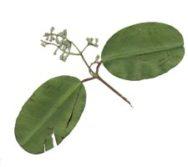
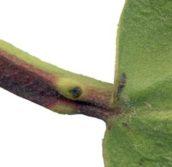
The white mangrove, Laguncularia racemosa, is the least salt-tolerant of the three mangrove varieties and cannot withstand prolonged periods in flooded conditions. For this reason white mangroves are usually found on drier land than are its red and black cousins. On St. John white mangroves are particularly plentiful around the edge of salt ponds and along guts where they open to the sea. The white mangrove, like the black, excretes salt from its leaves. It does so through salt glands that occur in pairs on the stem just below each leaf. These glands look like two raised bumps and provide a good way to identify the white mangrove.
The next time you pass the mangroves along the Leinster Bay Road or in town around Frank Bay Pond or elsewhere on the island, take a brief pause. Have a good look at these guardians of the shoreline, which quietly and modestly provide for the orderly flow of life between land and sea and are such an integral part of both our marine and terrestrial environments.
Salt Ponds
The complex balance of land and sea environments supports the incredible natural beauty of St. John, the white soft sandy beaches, the crystal-clear water, the colorful coral reef, the fish, the sea creatures, the exotic tropical foliage, the birds, bats, butterflies and every other living thing. One of these environments that is often overlooked is the salt pond.
How Are Salt Ponds Formed?
Most of the salt ponds of St. John were once bays, open to the sea. Coral reefs develop naturally around the rocky headlands that jut out and define bays. In time the reef may extend out from the headland toward the center of the bay. When this happens simultaneously on both headlands, the bay begins to be closed off. As the reef matures, the top of the reef rises toward the surface of the water. Strong storms and hurricanes carry sand, rocks and pieces of broken coral and pile them on top of the reef creating a surface platform above sea level. Meanwhile heavy rains and gut washes cause sediments and soil from the land to collect on the protected side of the platform facing the land. With the help of salt tolerant plants, such as mangroves, to secure these sediments, the platform will gradually get larger and denser. A salt pond is born when the spit of solid land builds up enough to close off the bay from the sea.
How Do Salt Ponds Protect the Coral Reefs?
During heavy rains, water runs down valleys and hillsides into guts leading to the low flat areas just inshore from the central portions of the bay. Salt ponds are generally found in these low-lying areas and serve as buffers between land and sea. The salt pond acts much like the septic systems used by many homes on St. John. Water flowing down the valley picks up soil, organic debris and possibly dangerous pollutants. This mix is deposited into the salt pond instead of washing directly into the sea. The sediments settle to the bottom of the pond and the now purified water can seep through the filter-like sand and coral rubble wall of the pond into the bay without causing turbidity or cloudiness.
The Salt Pond Environment
Salt ponds are extremely hostile environments for living things. Depending on the salt pond’s location and on conditions such as temperature, rainfall and windiness, the water within the pond can range from almost fresh to a super-saline solution five times the saltiness of the sea. Add to this the high temperature that the water can reach during sunny dry afternoons and you would think that nothing could survive there. Nonetheless, the salt pond is inhabited by such creatures as brine shrimp, crabs, insects and insect larva, which provide the basis for a food chain. Birds, waterfowl and bats that feed on these organisms are attracted to the pond environment and several species of birds tend to make their nests nearby.
Birds commonly found at or near St. John salt ponds include herons, sandpipers, yellowlegs, and pin tail ducks. In addition, certain fish, such as barracuda, tarpon, mullet and snook, attracted by the brine shrimp, sometimes make their way into salt ponds that have an opening to the sea. In some parts of the world the brine shrimp from salt ponds are harvested commercially for tropical fish food, and the larva produced by brine shrimp eggs has been marketed (particularly in comic books) as “sea monkeys”.
Salt ponds can be smelly and murky and in the past they were indiscriminately dredged, drained, filled or opened to the sea. As a result they have been disappearing from the Virgin Islands at an alarming rate. Fortunately, they are now protected under the territorial Coastal Zone Management department and also under federal legislation, which means no filling, opening or dredging.
If you would like to observe a St. John salt pond, the best time to visit is in the early morning, while it is still cool. The morning is also the best time to bird watch at the ponds. Some easily accessible and healthy pond environments can be found at Frank Bay, Europa, Grootpan and Salt Pond Bay. Salt ponds tend to be peaceful and quiet areas. Take your time, stand still and look about carefully; you’ll be pleasantly surprised at all there is to see and contemplate.
Sand
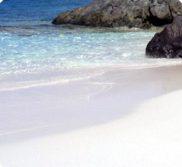
Where does the sand come from?
The satiny soft coral sand found on the majority of St. John’s beaches comes, almost entirely, from the coral reef community. This is the main reason why our sand is so much finer and softer then the sand found on most continental beaches, which comes from terrestrial sources, such as the weathering of rocks.
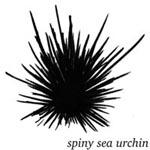
Most of our sand is produced by the force of waves and currents acting on the coral reef as coral, calcareous algae, (algae with a hard exoskeleton) the shells of various sea creatures and sea urchin spines (which make up those little black grains of sand) are gradually broken down into sand sized grains.
In addition, reef grazing fish, such as parrotfish, produce a significant amount of the sand found on our beaches. Parrotfish exist on a diet of algae, which they scrape off the surface of coral rock with their fused teeth that look like a parrot’s beak. They then grind this coral and algae mixture to a fine powder. The algae covering the coral are absorbed as food. The remainder of their meal passes through their digestive tracts and is excreted in the form of sand.


Parrotfish are not shy and by donning a mask fin and snorkel, you can easily observe them at work and even hear the sound of their beaks scraping against the coral, then every so often you may witness them relieving themselves of the indigestible portions of their meal in the form of a fine sand that will settle slowly to the bottom of the reef.
Other grazing fish, such as the blue tang, perform the same function. The amount of sand produced in this manner is considerable – about one ton of sand per acre of reef per year.
How does sand get to the beach?
Sand is basically a waste product of the coral reef. This waste, which would otherwise suffocate the coral, is removed by the action of waves and currents over the reef. This sand collects in a kind of storage area around the perimeter of the reef.
During the winter, large ocean swells are generated by storms and cold fronts coming from North America and from over the central Atlantic. When these reach the north shore of St. John, they become steeper and break on the shore. This winter phenomenon is called ground sea and it serves to move the sand from the storage areas around the reef deposited it on the beach.
In the summer the same process can occur on the southern coasts, caused by the action of the trade winds or by tropical storms or hurricanes coming from the southeast.
How is sand lost from beaches?
Although sand is regularly brought to the beach from the sea, it is also consistently being lost from the beach. Because most St John beaches are found within bays protected by headlands or points on both sides of the beach, sand is not washed laterally along the coast and lost in this manner, as is the case on the beaches of the continental United States.
However, sand from the drier upper portion of the beach is often blown by winds past the line of vegetation where it will stay forever in the form of soil.
On the wetter lower beach, sand is constantly washed back and forth by waves. This makes the grains get smaller and smaller. When they get so fine that they go into suspension, they are washed back out to sea and lost.
Hurricanes or strong tropical storms are other natural phenomena that could result in sand loss. Large storms may either take away or add sand to existing beaches. They may even create new beaches. In general, extremely high ground seas and hurricanes accompanied by high tides will send large amounts of sand past the vegetation line or wash it back out to sea so far that the depth of the water will be too deep for the sand to be recycled by ordinary ground seas. Moreover, these storms often destroy large sections of reef, reducing the sand supply for years to come.
The lost sand will be replaced reef community and the beaches will remain in their sandy state. That is, as long as the dynamics of sand production and sand loss are in balance. This balance can be disturbed by natural causes such as hurricanes or coral diseases or as a result of interference by human beings in the natural order of nature. This interference can create a more insidious and continual imbalance, then imbalances caused by natural factors.
Removing sand from the beach or the sea floor can have extremely long lasting effects. For example, dredging operations take sand from sand storage areas, preventing it from reaching the beaches in times of ground seas or tropical storms.
Taking sand from the beach can also be irreversible. When St. John first began to experience the boom of tourism with the resultant construction of roads and buildings, a great deal of sand was taken from the beaches to make concrete. The loss of sand in this manner was so dramatic that the beaches never recovered and some of north shore beaches are now considerably narrower than they used to be. For instance the now narrow Maho Bay used to be on of the widest beaches on St. John. The process of recovery from this interference is extremely slow, and if the dredging or the mining of sand is continual, the sand beach will be replaced by rocky shoreline.
The worst threat to beaches comes from damage to the coral reef.
It is important to remember that a healthy coral reef is responsible for the continued existence of our beaches, and those factors that negatively impact the reef, such as pollution or runoff caused by irresponsible development will eventually lead to the disappearance of our beaches, which are, perhaps, St. John’s the most valuable resource.
Seagrass
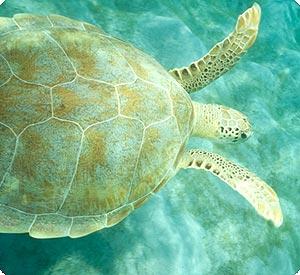
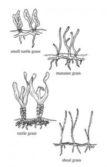
Local seagrass species include shoal grass, turtle grass and manatee grass. These underwater grasses are commonly found on the sandy bottoms of calm bays and between coral reefs. They reproduce and grow by means of an underground root called a rhizome, which lies down horizontally just beneath the sand. From this rhizome the blades of grass grow up and the roots grow down, forming a mat of root fibers that hold the seagrass to the ocean floor. Seagrass is dependent on sunlight and therefore, cannot tolerate cloudy water for extended periods of time.
Seagrasses control erosion by holding down loose sandy soils with their mat of roots, thus protecting our beautiful beaches. Moreover, they help prevent turbidity, or water cloudiness. This is an important function because cloudy water blocks out sunlight.
Seagrasses control turbidity by trapping sediments washed down from land during rains and ultimately incorporating them into a seabed soil that is held securely by the seagrass roots. The blades of grass also slow down bottom currents and keep loose sediments from getting churned up.
Seagrass beds support a great deal of marine life. They provide nutrition for the green turtle and queen conch, and serve as a habitat for many species of juvenile fish and other sea creatures that are small enough to hide between the blades of grass.
Although not quite as sensitive as corals, seagrasses are also threatened by turbidity. They are currently in grave danger from the exponential increase in residential and commercial development on St. John. The prime turbidity-causing culprit is the failure to pave roads. Other enemies of clear water include unprotected and irresponsible excavation, especially on steep slopes, and improper sewage treatment.
A more immediate threat to seagrass comes from the proliferation of boat anchoring. The act of setting down and then pulling up an anchor tears the seagrass up by the roots and destroys the rhizomes, making recovery slow and difficult. Worse yet, when anchors are set improperly, they may drag, causing widespread damage that often includes injury to nearby coral reefs. Moreover, as an anchored boat swings around in the wind, the anchor chain is dragged over the sea floor in an arc, destroying all the grass in its path.
Years ago, harbors such as Caneel, Maho and Francis Bays had extensive seagrass cover. In those days literally hundreds of conch ambled slowly through the seagrass leaves at the bottom of the bays. With the advent of modern tourism and the great increase in the number of boats anchoring in these picturesque and well-protected harbors, the seagrass has all but disappeared and the conch population has plummeted.
Today a mooring program has been instituted whereby mariners enjoying many of the most popular bays in St. John may secure their vessels to moorings as an alternative to anchoring. The mooring program is a powerful step towards the preservation of seagrass and coral reefs. Unlike anchors, moorings are relatively permanent fixtures. This minimizes the disruption of the seabed. Moreover, moorings do not depend on heavy chains lying on the sea bottom for a secure bite, nor are they subject to dragging.
Hopefully, in addition to the mooring project, future development of St. John will be conducted in an environmentally responsible manner, keeping the bays as clear and as free from turbidity as possible. Seagrasses tend to be resilient. If the stresses to their survival can be eliminated before it is too late, there is an excellent possibility that our once extensive fields of underwater grasslands will recover fully and will flourish as they did in the past.
Inland Terrestrial Environments
Moist Forests
Moist forests are generally found in areas receiving about 45-55 inches of rain annually; usually at the high elevations or in valleys along the north shore of the island.
Trees found in the moist forests form canopies that can be 75 feet high or higher.
Common trees of the moist forest include genip, strangler fig, kapok, mango, hog plum, West Indian locust, bay rum,guavaberry and sandbox. Shade tolerant plants such as teyer palms, false coffee, sweet lime, anthuriums and bromeliads grow under the canopy.
Dry Forests
Dry forest vegetation is found predominantly on the western end of the island and in low-lying southern valleys.
Common dry forest trees include turpentine, mampoo, manjack, white cedar and West Indian birch. Lignum vitae once the dominant species in the dry forest, is now scarce as a result of over-forestation.
Cactus Scrub
Cactus scrub environments are found in the drier areas such as the East End. Plants typically found in these locations include cacti such as prickly pear, barrel and pipe organ varieties, maran bush, guinea grass, century plants (agaves), acacia (casha bush), night blooming cereus, wild tamarind, catch-and-keep and wild frangipani.
Guts
When rain falls on the mountainous slopes of St. John, the surface and ground water travel downhill and collect in natural rocky drainage channels locally called “guts.”
The guts run down the valley and empty into collecting basins that might be bays, salt ponds or mangrove forests. The land adjacent to guts is wetter and more fertile than other sections of the valley and are more lushly forested.
